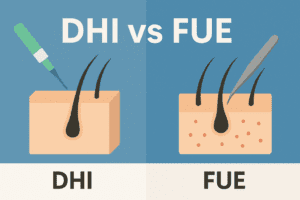People have been trying to find a reliable way of dealing with hair loss for centuries, but it wasn’t until the 90s that the first successful hair transplants were performed.
The early method was called Follicular Unit Transplant or FUT, and it involved cutting a strip of skin from the back of the head and then breaking it down into separate follicular units. These could then be implanted into tiny incisions in the bald areas.
Over the years, the techniques were refined, and in modern procedures like FUE and DHI, follicles can be extracted directly, with minimal scarring, and implanted more precisely. We will go over both of these methods and look at their unique benefits and limitations to give you an idea of what the best option is for you.
What is a FUE Hair Transplant?
After the initial consultation, where the doctor determines the number of grafts needed and creates a realistic hairline, the donor area at the back of the head is trimmed for easier access, and the patient receives local anaesthesia. The surgeon then extracts individual grafts, each containing 1–4 hair follicles, with a specialized tool, and preserves them in a solution so that they remain viable for the next 24 hours.
They then use a metal or spear-tipped sapphire blade to make micro incisions in the recipient area. The surgeon pays special attention to keep the proper spacing, reach the right depth, and come in at a specific angle so that the donor strands can match the natural density and growth direction of the surrounding hair.
The grafts are then placed within the incisions, which will take several more hours. When everything is done, the patient receives instructions on proper post-op care and a supply of the essential products they will need to use.
What is a DHI Hair Transplant?
The basic initial steps are the same as with the FUE method, however, as soon as the follicles from the donor area are extracted, they are loaded into a Choi Implant Pen. This tool has a hollow needle point that allows the surgeon to puncture the scalp and implant a graft simultaneously, while also leaving a smaller wound canal that will heal faster.
This method offers a lot of precise control over the depth and angle, and allows for closer graft placement that leads to a thicker look. There is also an option that makes use of the latest technology, called Robotic DHI, where the follicles can be extracted and implanted in half the time compared to the standard procedure.
FUE vs DHI Hair Transplant Procedure: Key Differences
While these two options are a bit similar, they have a few distinctive features that make a big difference in how they are applied and the type of results you can expect.

The Best Candidates
The FUE method is preferred for cases where larger areas of the scalp have to be covered, requiring between 3,500 and 6,000 grafts in total. The ideal candidate is a person in their late 30s to early 40s or older, with more severe hair loss, stages 4 to 6 on the Norwood scale.
With DHI, you can transplant 2500 to 3500 grafts, which is perfect for younger individuals with a receding hairline, stages 3 and 4 Norwood, or those who need a beard transplant. It’s also a good choice for women, with the no-shave option.
Recovery Time
It takes around a week on average for the swelling and redness to go down after a traditional FUE operation, while you can expect to be back to your regular routine after just two days with the DHI method. That’s because the Choi implanter causes less tissue damage, so there is also less bleeding post-op, though the Sapphire FUE offers similarly quick recovery times.
Prices
The FUE method is generally less expensive than DHI, with the former costing around $2,500 on average in Turkish clinics offering Hair transplant in Istanbul, while the latter is around $3,500.
Results and Success Rates
Most people are mainly interested in the end result, so we need to examine what kind of look each of these procedures can give you, and how successful they are in general.
A skilled surgeon who takes great care to properly preserve each hair follicle can have a 95% or higher success rate with FUE, and this number goes up to 98% or higher with the DHI method.
The implanted hair will also be thicker with the latter option, as the grafts can be placed closer together, but the former is the only way to achieve full restoration for those in the later stages of male and female pattern baldness.
Pros and Cons of DHI and FUE Hair Transplants
Now that we’ve covered all the important details about these surgeries, here is a quick overview of the benefits and limitations of each so that you can have an easier time choosing between them.
FUE | DHI | ||
Pros: | Cons: | Pros: | Cons: |
Great for any stage of male/female pattern baldness. | Slightly worse graft survival rates. | Denser, more natural-looking results. | Only for less severe hair loss. |
Less expensive. | More bleeding and scabs during recovery. | Fast recovery. | The procedure lasts longer. |
Faster procedure for large areas. | Leaves small, dot-like scars. | Minimal or no scarring. | More expensive. |
Works better with curly Afro-style hair. | Less precise positioning to match growth direction. | Slightly higher success rate. | Requires a more skilled surgeon. |
Which Option is Better for You?
When you look at all the different variables between these two methods, it’s easy to see that the ultimate choice will depend on each person’s specific needs. You have to consider your budget, the extent of your hair loss, whether you prefer denser hair, and the recovery time.
For example, people with Afro hair should go with FUE, as it is better suited for the tight curly structure of the follicles, while those who just need a little bit of work around the hairline and beard would benefit from DHI. Ultimately, you should consult the professionals at reputable clinics like Asli Tarcan to get a more precise understanding of your options.

